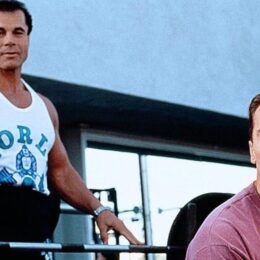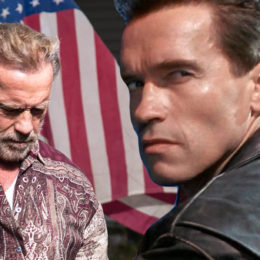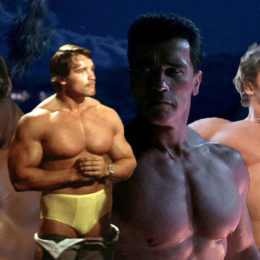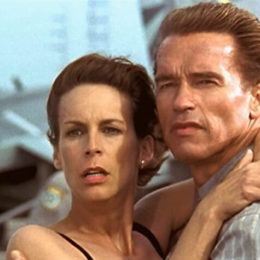CONAN THE BARBARIAN. Messiah, philosopher and cannibal
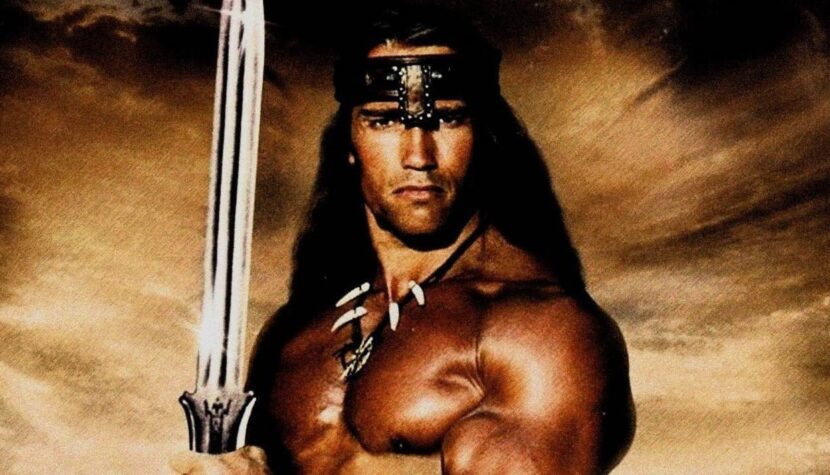
The plan was to release the subsequent parts of Conan the Barbarian every few years, similar to the James Bond franchise. Stone’s approach to the project was ambitious, and the entire series was to be based on the construction of Hell as depicted in Dante’s Divine Comedy, with its nine circles.
The Beginnings
The 12-part story of Conan the Barbarian was intended to take place on both Earth and in Hell, with a post-apocalyptic setting. Some remnants of this idea can be seen in the stuffy and grotesque Orgy Chamber, which brings to mind one of Dante’s infernal circles. The individual plotlines were based on Robert E. Howard’s stories and Roy Thomas’s Conan comics. Stone also created an extensive bestiary of monsters featured in the film, mainly mutants – dark hybrids of humans and animals, which left traces in the cannibalistic scenes in the Orgy Chamber.
The project was to be grand in scale, with significant production resources. Stone envisioned Conan’s world as permeated with magic, monsters, and numerous spectacular battles. Unfortunately, the fantastic vision did not match the real capabilities of the filmmaking industry at the time, nor did it fit the budget. The prospect of a 12-part cycle was highly risky and therefore discouraged producers from getting involved.

After the script was purchased, the project was accepted and underwent further development. Several directors, including Alan Parker and Ridley Scott, were considered for the job. Eventually, John Milius was chosen, known for his exceptional dialogue writing for films like Apocalypse Now and Dirty Harry. Based on Stone’s powerful script, Milius created his own version of the screenplay. It’s worth noting that, similar to the first version, the film was originally supposed to end with a spectacular battle, which was later changed during the project’s development.
Milius had his own vision for the series, which he called the Trilogy of Steel. The first part, Barbarian, was focused on Steel and Sword and the Power they possess. The second part was to be about Responsibility, exploring how to wield steel responsibly, and the third part would delve into Loyalty and the consequences of possessing such power. However, this ambitious plan, like the first one, did not withstand the test of time.
Only the first part, Conan the Barbarian, was realized, and Conan the Destroyer is not a child of the original concept. Milius, a passionate historian and militarist, introduced a major change to Stone’s ideas by limiting the use of magic and the fantasy world in favor of numerous references to history and the mythology of ancient people. He created a more credible world, heavily inspired by Viking culture (the initial invasion of “horned” warriors), Greeks (snake symbolism), and Japanese (philosophy of combat). As a result, the parade of monsters was minimized, and the mass slaughtering of them was reduced in the film.
Related:
In Milius' world, magic is a natural but secondary element that does not dominate over human civilization.
The film is credible in its intent to portray an ancient history, thanks to the abundance of references (cities, costumes, combat techniques) and the mortality of Conan himself (he is a hero, but above all, a man of flesh and blood, who could just as well be a warrior from a historical film). Milius thus made a transition from heroic fantasy to the so-called low fantasy (with a low concentration of fantasy elements, in favor of historical elements), while serving Magic with moderation. A significant role in the film is also played (thanks to Milius) by polytheistic religion and myth – the gods are a source of power, objects of intercession, and masters of life and death.
The reference to low fantasy is not unfounded, as the entire world of Conan, according to R. Howard, is partly based on Greek mythology – the plot of the stories takes place in the land of Hyperborea around 12,000 years BC, and the races present in the Hyborian Age (including the Cimmerians) are descendants of the legendary Atlanteans and Picts (known, for example, from Arthurian legends).

In the main roles, Milius cast actors who were not of the highest calibre and had little experience (with the exception of the excellent James Earl Jones) – dancer Sandahl Bergman and windsurfer Gerry Lopez. The director’s intention was to emphasize movement and physicality of the actors – it was to be a film of motion, bodies, and combat – virtuosity in acting was not the primary focus.
Milius carefully selected the actors to match his vision of each character: Arnold – a powerful, muscular barbarian; Bergman – a Valkyrie with a divine body and captivating, almost acrobatic grace in movement; Lopez – an agile, small Mongolian warrior. The film aimed to charm with beauty and artistry of combat, physicality, and predatory nature of the characters. Consequently, the dialogues were reduced (though still excellent). It seems that the main narrative role was entrusted to the music of Basil Poledouris, which, being pervasive and incredibly picturesque, becomes the actual language and voice of the story. Thus, it can be confidently stated that Milius sought to create a frenetic dance of bodies and the art of strikes, a gallery of duels intoxicated with an abundance of blood and the dignity of the omnipresent music. However, Conan is also, as befitting the fantasy genre, a grand adventure…
Conan represents the heroic fantasy genre, where the plot revolves around the protagonist’s journey to fulfill successive tasks (quests) that bring him closer to the ultimate goal and motivate him to act. The film’s linear structure can be considered exemplary for this genre: Primary Quest – revenge – assembling the party – 1st quest to obtain the Eye of the Serpent – leading to the trail of the Antagonist – 2nd quest to rescue King Osric’s daughter – leading to the first confrontation with the Antagonist – 3rd quest to defeat the Antagonist’s henchmen – leading to the final duel and the fulfillment of revenge.
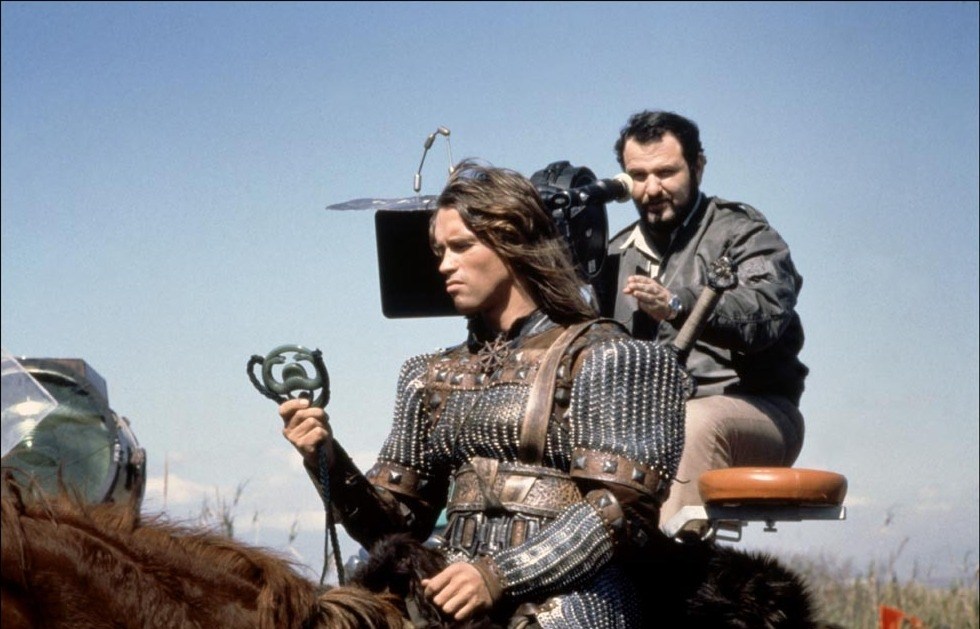
An interesting technique is the gradual assembly of a team that complements each other, forming a single complete warrior. The Barbarian represents strength and hand-to-hand combat, the Valkyrie agility and nimbleness of a thief, the Warrior the skills of ranged combat, and the Sorcerer serves as a link to divine forces, as well as a seer and representative of other mental powers. As I mentioned earlier, this transformation is achieved partly due to Howard (the precursor) and partly due to Milius, transitioning the film into the low fantasy genre. As a result, we won’t encounter monsters in the film (with the exception of the giant snake), nor mutants, peculiar races, or spellcasting. Magic is to a large extent replaced by divine intervention and mesmerism. However, the screen is vibrant with the spirit of ancient civilizations and barbarism.
The screenplay of Conan is also an extraordinary journey through the prose of Robert E. Howard
Reading through the subsequent stories, we may encounter episodes that were incorporated into the film. The creators of the screenplay synthesized various elements from Howard’s tales, integrating the most captivating threads into an entirely new story crafted for the movie (the quest for revenge against Thulsa Doom).
The film begins with the raid of Thulsa Doom’s tribe on Conan’s village. His parents are murdered, and the tribe is exterminated. Conan is taken into captivity and forced to work at the Wheel of Pain. Later, he becomes a gladiator. This is the first significant difference between the prose and the film – revenge becomes a driving force behind Conan’s actions. In Howard’s stories, Conan was born on a battlefield, foreshadowing a life of bloodshed and warfare. At the age of fifteen, he participated in his first major battle, and along with his people, looted the fortress of Venarium. A year later, he was captured and became a gladiator. The conflict between Conan and Thulsa Doom and his followers has no connection to Howard’s original tales. However, against the backdrop of the unfolding duel, we discover a plethora of references to various stories. Here are a few threads that I managed to discern:
In the tale The Thing in the Crypt, Conan, while escaping from a pack of wolves, stumbles upon a crypt of ancient warriors, where he finds an extension of his hand – a sword.
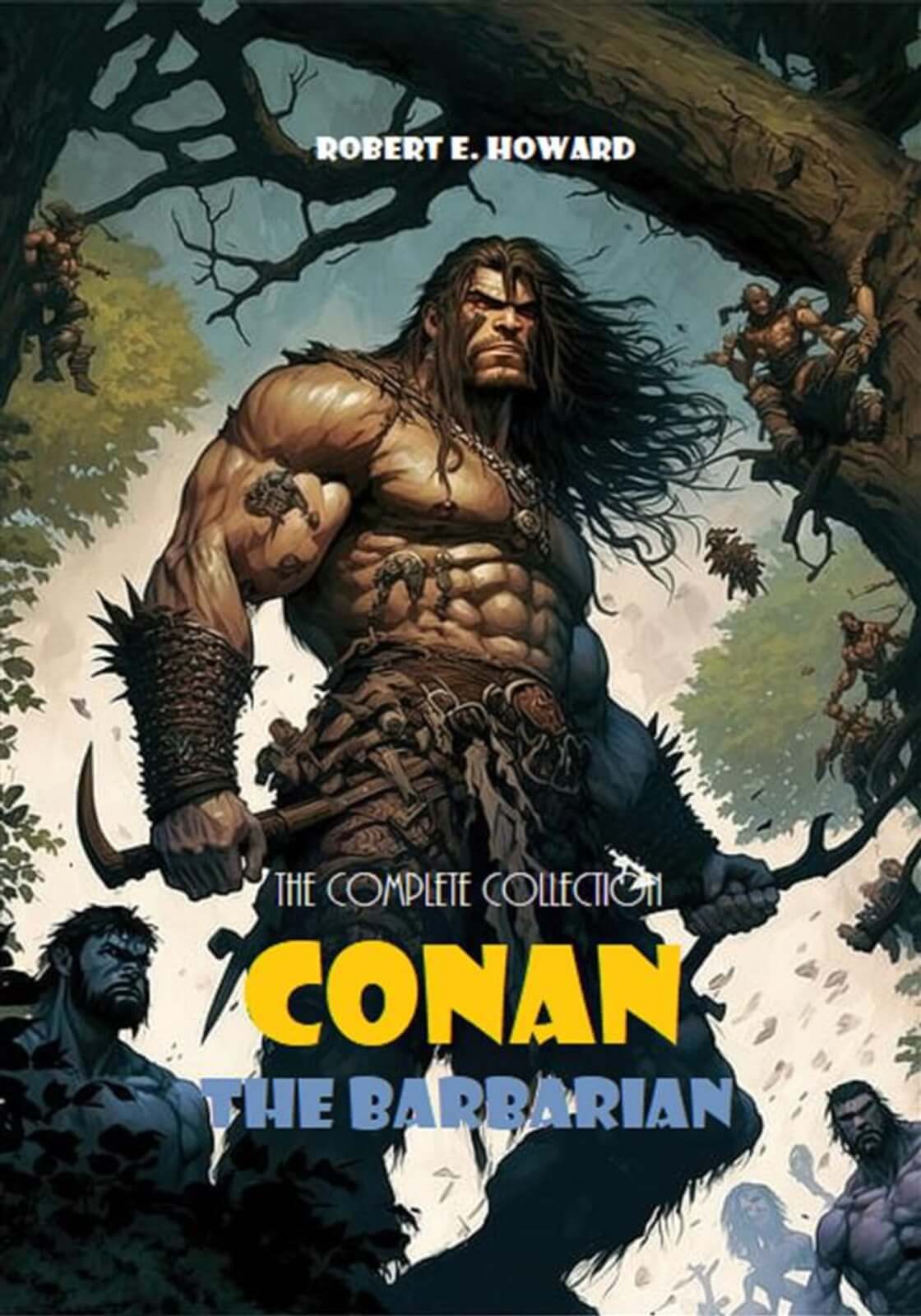
In The Tower of the Elephant, Conan desires to plunder the Tower of the Elephant (in the film, the Tower of the Snake). At its foot, he encounters the thief Taurus (in the film, the thief Valerie), and they venture into the tower together. Their prize becomes the Heart of the Elephant jewel (in the film, the Eye of the Snake).
In The People of the Black Circle, Conan encounters the caste of Black Sorcerers, surrounded by the cult of Acolytes (much like the Snake Cult in the film). The chief sorcerer is the Ruler of Yimsha (a precursor to Thulsa Doom), and both the sorcerer Khemsa and the Soothsayers possess mesmerism. Under hypnosis, a Handmaiden throws herself into the abyss (similar to Thulsa’s Acolytes). In the climax, one of Conan’s allies from Iranistan is killed by an arrow that transforms into a snake inside the victim (like Valerie), while the others, under the influence of mesmerism, suffer decapitation (like Conan’s mother). Additionally, the Ruler of Yimsha has the ability to transform into a giant snake (like Thulsa Doom), whom Conan defeats in the finale (in the same manner as the Snake from the Tower in the film).
In Shadows in Zamboula, a group of cannibals terrorizes people at night (similar to the snake cult followers in the film).
In A Witch Shall Be Born, Conan is crucified by Constantius on a cross (in the film, by Thulsa on the Tree of Woe), and he fiercely resists the vultures. Later, Conan undergoes a second trial when his savior decapitates the crucified barbarian along with the cross (and of course, Conan escapes from it). In the film, Conan is saved by his loyal friend Subotai (earlier, Conan rescued him from the Witch).

The beginning of the film shows us the arduous process of forging the sword – a journey that becomes a metaphor for Conan’s life path. The film is a tale of steel and strength, and in this case, steel also symbolizes the unwavering character of the hero, his journey of improvement, and will to survive. Conan’s father instructs him to place his trust solely in steel – it’s the only thing he can rely on. Young Conan takes this lesson to heart. We meet him at a time when the Cimmerian lands are likely engulfed in bloody battles for steel – the attack on the village likely has such a purpose. The turning point on the Path of Steel in Conan’s life is the murder of his mother. It is then that Conan encounters his greatest enemy and learns his fighting style – harnessing the power of the body and mental strength. When his mother dies and her hand releases Conan’s grip, the young man’s hand becomes empty. Conan shifts his gaze not to his mother but to his enemy. From that moment, that hand will hold something else – from that moment on, carefree childhood will be replaced by the desire for revenge, the path of murder and rape. In this symbolic scene, Conan is ripped from his previous life – his hands are destined to hold steel – the legacy of his ancestors, the idea of his god – not to reciprocate the warm embrace of his mother.
The next stage in “forging hot steel” is the Wheel of Pain – years of hardening the body in brutal slave labor. Conan builds his strength – his terrible fate becomes his ally – the Wheel of Pain – a training that brings him closer to his goal. When we have the “blade,” we must sharpen it. As a gladiator, Conan learns the secrets of hand-to-hand combat. Initially, he is disoriented in the world into which he was thrown, but gradually gains confidence, becoming a master and a ruthless slayer. When the sword is ready, it’s time to learn how to wield it. Conan learns the art of using a katana and military tactics. He becomes a true warrior – a weapon wielded by his own strength. He is no longer a mindless killer but also a technician, a strategist, and a philosopher. The final step on the path of steel and the sealing of Conan’s destiny is the “meeting” in the crypt. After regaining long-lost freedom, Conan is thrown into the whirlwind of a new, unknown world – quickly realizing that he is defenseless against wolf fangs and claws, with only escape as an option. In the crypt where he finds shelter, he discovers the essence of his god, Crom, who, like his father, points him toward his further path and destiny – in a symbolic scene, Crom hands Conan the sword (the skeleton of a great hero collapses and turns to dust) – steel, the only thing he can trust. His hand grips the hilt, which was meant for him. It’s like shaking hands with Crom himself – completing the ritual of crafting the “Sword.” Conan has cooled in the cold of steel – now it’s time to deliver the blow of vengeance with the sharp edge.
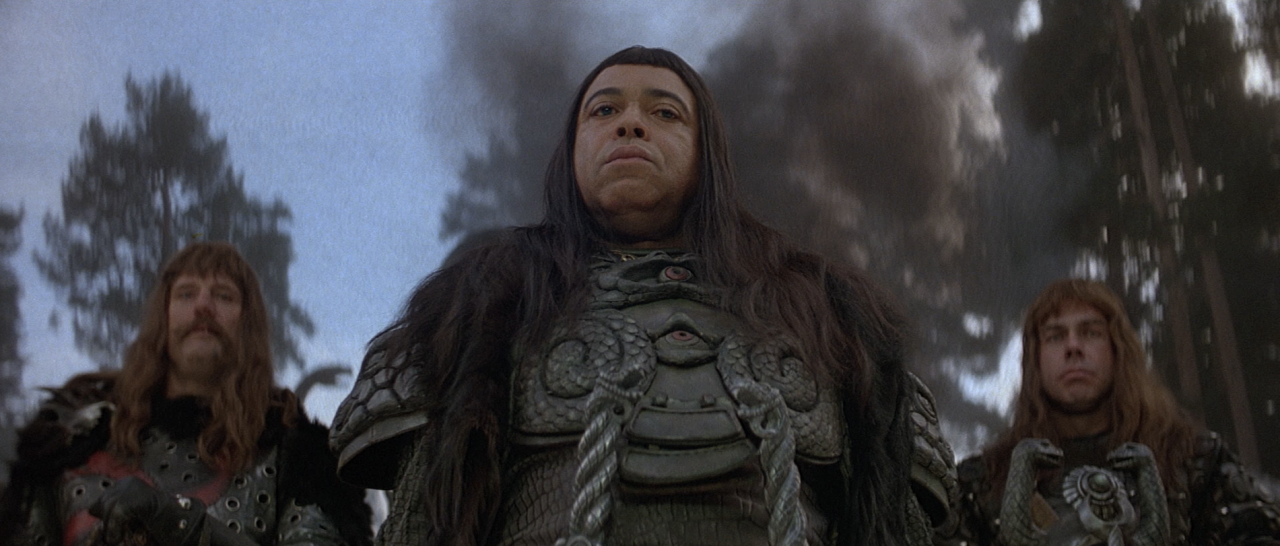
In the next sequence, we see Conan dressed in wolf skins – the sword will help him many more times, this time providing him warmth and safety. From now on, he will hunt those who once hunted him. The first test of Steel comes when Conan meets Thulsa Doom for the first time. The sorcerer demonstrates the power of the body, manipulating a priestess into a hypnotic trance and encouraging her to commit suicide. “What is steel compared to the hand that wields it?” Thulsa says. The seasoned warrior abandons the pursuit of steel and the attempt to understand its secrets in favor of the power of the body – magic and hypnotism. His hand possesses a different kind of power – sinister, untrustworthy, and treacherous. The barbarian does not falter and once again puts his trust in steel. His hands are nailed to a tree, and his soul dances with demons on the burial mound – yet Conan survives because his strength of will and desire for revenge are stronger than death. The barbarian who returns from the realm of the dead will once again, like when he was a child, look at his open empty hand. He looks at it with respect and certainty because he knows that he returned from the encounter with death for one purpose – to once again wield the Steel – his father’s teachings and Crom’s Will – the only thing that can give his violence-marked life meaning and purpose.
And now comes the final test of Steel – the culmination of the relentless path of vengeance. Body against Steel, mesmerizing eyes and magical gestures against the Sword and the wielding steel tendons. The symbolic scene of the duel brings to mind the initial clash between Thulsa and Conan’s mother. But this time, the sword triumphs over the body, magic succumbs to the strength of will, determination, and insatiable desire, the head yields to the force of ringing steel. “What does not kill us, makes us stronger,” Nietzschean prelude to the story also contains the philosophy of Conan. The child who had faith in his own self-improvement and the consistent overcoming of obstacles became a superhuman warrior, accomplishing great and noble deeds. The destructive force that triggered the desire for revenge ultimately shaped Conan himself – his strength, a character as unyielding as steel, and the will to live. In the final conversation between Conan and Thulsa, the sorcerer calls the barbarian his son. And in reality, it is true – the relationship between Thulsa and Conan is a fascinating journey into the depths of Nietzsche’s philosophy. The steel superman emerged from the hammer of his greatest enemy.

It is a common and unfair misconception to label Conan as stupid or simple-minded
From a superficial reading (or merely skimming) of the pages of R. Howard’s books or watching the film with, one might come to the conclusion that Conan was brought into existence solely to use his great muscles and wield his sword without restraint, quickly seducing any encountered woman. Furthermore, he would revel in feasts and gather all sorts of profits in the form of precious jewels and artifacts. Indeed, the very title Barbarian seems to associate him more with negative character traits than with a heroic lineage. So, is Conan a ruthless and thoughtless troglodyte bent on total destruction (as seen in games like Diablo)?
Upon closer observation of Conan himself and his adventures, be it within the pages of novels or on the film screen, one can arrive at the opposite conclusion – that he is, in fact, a sage and philosopher rarely seen in the world of fantasy. Conan comes from a barbaric lineage, not as civilized as some of the nations in the Hyborian Age, which may negatively affect his perception – a brutish orc, plundering and looting. However, the truth is that Conan possesses many qualities of a medieval knight and a sage. Above all, one can notice in the barbarian’s conduct a certain resemblance to the ethical principles of Japanese samurais. Bushido, the “way of the warrior,” is the honorable code of samurais. Already in the initial sequences of the young warrior’s training, we find references to this ethos – Conan is trained under the guidance of an Asian master in the art of wielding a katana (the sword of samurais). The director himself admits to attempting to incorporate the spirit of Japanese swordsmanship and philosophy into Conan’s movements. Initially, in the scene where the barbarian is freed from the Wheel of Pain, where he spent long years of torment, he was supposed to bow and express gratitude – which was meant to be a reference to Zen philosophy. At every turn, Milius subtly weaves an element of oriental spirit into the fate of his barbarian.

Conan always acts according to the broadly understood principles of bushido
He exhibits kindness (saving Subotai and never killing for pleasure), courage (being a symbol of bravery and strength), nobility (never taking a woman against her will), self-improvement (constantly honing his fighting skills and acquiring wisdom, culminating in becoming a sage and ruler), loyalty (remaining faithful to his principles, god, and people), honor (keeping his promises and rescuing King Osric’s daughter), justice (sharing the loot from the Tower of the Serpent and acknowledging the greatness of Subotai’s god despite his own belief in Crom).
Indeed, the character of Conan is more akin to a Japanese samurai than a stereotypical barbarian. Milius, while creating his hero, bestows upon him traits of various warriors known from history at different stages of his life. Conan is depicted as a Roman gladiator in the beginning, then as an adept in Asian martial arts wielding a katana. He later appears as a Mongol warrior, then a barbarian clad in wolf skins, and even dons a camouflaged outfit reminiscent of stealthy ninjas. During the skirmish in the ruins, he wears a horned helmet resembling that of a Celtic warrior. Thus, Conan becomes an eclectic warrior, drawing from the best of historical military and combat practices, becoming a complete and historical hero.
It is also worth noting that the dark side (Thulsa Doom’s followers) is a faithful nod to Viking culture, with horned helmets, axes, mustaches, and the initial raid on the village effectively depicting the actions of ancient Scandinavians.

Two scenes in a sense depict Conan’s assumed martyrdom (or even messianism). The first is his ordeal at the Well of Souls. Conan is exposed to a challenging trial for the first time in his life, from which he emerges humbly. It is the first stage in a chain of sufferings orchestrated by fate and the director. Some controversies have arisen around this beautiful and meaningful scene, where a clever montage shortcut was made. The main question is how Conan survived and grew into a strong, capable, and well-fed warrior, spinning in circles for several years.
A curious hypothesis can be found on the excellent website about Conan (www.conan.prv.pl), where one of the articles proposes the idea that Conan practiced cannibalism. This assumption is based on the gradual disappearance of his companions in misery (only hanging chains remain), and Conan’s systematic development until he is left alone at the wheel. However, this theory casts a shadow over Conan’s character, and it seems unrealistic for him to survive for so many years with only 8 or 9 emaciated companions with whom he would probably have to share what little food they had to stay alive.
The second controversy arises from the lack of a reasonable explanation for this scene, making it illogical and unsuccessful. However, it is essential to consider that it is a montage shortcut in which only the most important aspects are shown, while the rest is omitted. The main purpose was to depict Conan’s growth and consistent pursuit of his goal (which sets the stage for the entire plot). The question of what Conan ate can be left to our imagination. Perhaps they worked during the day and ate and slept at night. The presence of a well and a mill with a grinding stone may indicate that the boys worked in food production, providing ideal conditions for growing into a super hero and building a muscular physique like Arnold.
In the end, these scenes are open to interpretation, and the filmmakers intentionally left some aspects to be inferred by the audience, adding to the mystique and complexity of Conan’s character and journey.
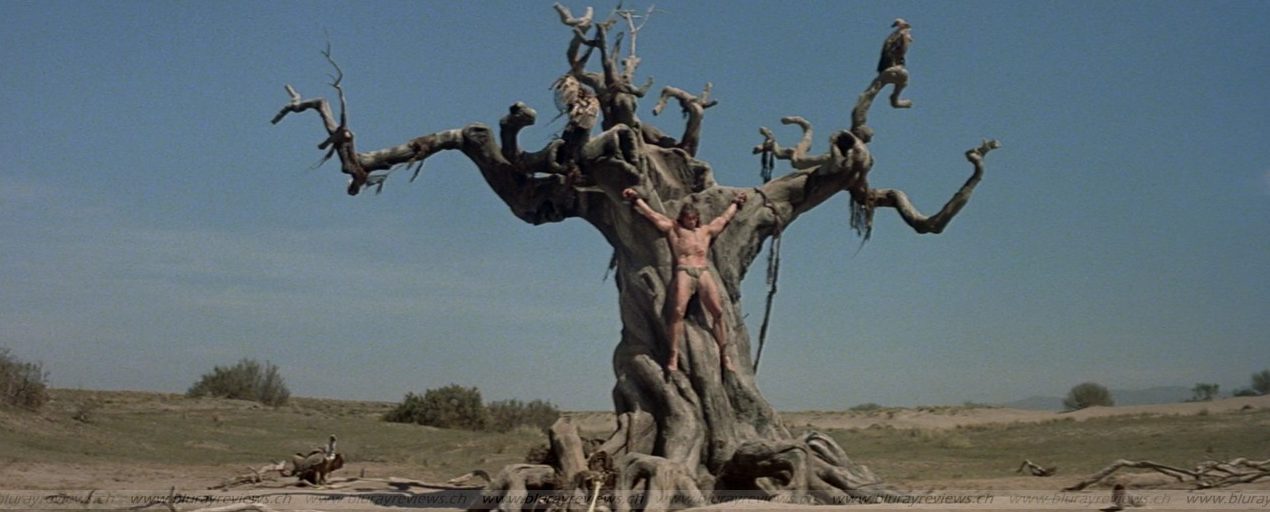
We now come to the picturesque scene of crucifixion.
First, there’s the trial of an angry mob, with Thulsa playing the role of the judge. Conan, battered and bloodied in torn clothes, awaits the verdict – crucifixion. Nails pierce his hands and feet, and he hangs on the cross, his bare torso exposed to the scorching sun in the vast, lonely desert. Doesn’t this remind you of something? The reference to the Gospel seems evident, although considering that the film is a historical mix, it is not entirely certain. What is certain, however, is that Conan does not accept such a fate. Instead of surrendering and dying a martyr’s death, he musters the last of his strength and defeats the vulture – with his own teeth. This is the essence of Conan, unyielding in his pursuit, fighting until the very end, with a steel-like character and an affirming will to live – he embodies anti-messianism.
As a result, Conan stands at the threshold of death, and here (following the Gospel’s trail), his resurrection occurs. After battling the demons, Conan survives mystical practices and escapes death’s grasp. This is a symbolic scene where revenge (unfinished revenge on the murderers of his people) and love (Valeria fighting demons) prove stronger than death. Therefore, we can speak of a certain reversal in these scenes – Conan dies on the cross, but on this cross, he also fights, then he is resurrected, not to save others, but to continue fighting and shedding blood in the name of justice. Ergo: Conan is merely a man, awaiting his own salvation, and his connection to the Gospel lies in the similar consequence in pursuing a goal, a mission with an inevitable ending. Nevertheless, this scene may indicate the extraordinary nature of the main character – another stage in tempering his character. A superhuman will to live.
In the world created by R. E. Howard, there are very few unattractive women.
In the world created by R. E. Howard, practically all women encountered by the barbarian on his journey are incredibly attractive, slender, long-legged, enticing, and worthy of desire. They exhibit various behaviors – some are charming and seductive, others are greedy and mischievous, some hold the title of princess, while others are village witches – but they all share one thing – undeniable beauty, grace, and charm. The fantastical nature of Howard’s world is evident in the creation of both supermen and superwomen. It may not be a realistic portrayal, but it is a delightful and pleasing tendency for the reader’s imagination. Interestingly, John Milius follows the same path in his adaptation. All the female characters in Conan are of exceptional beauty and extraordinary charm – a sight to behold and a delight to the heart. At this point, I can only pay homage to Howard for being able to flatter the reader, taking them to a truly paradisiacal garden, where the archetype of the perfect man consistently encounters and captivates women equally perfect in their essence. And also to Milius, who faithfully transcribed this into his film.
Thulsa Doom horde
A few words about Thulsa Doom’s acolytes. His cult is perhaps the most degenerate horde in the history of cinema. Firstly, they are stylized as hippies – commune, flowers, and hallucinogenic fumes. Secondly, one of the higher acolytes tries to seduce Conan, raising suspicion about the rest of the group. However, we get to know them better in the Chamber of Orgies – they eat soup from human hands and spend their free time in orgiastic marathons. Add to this ritualistic murders, regular murders, murders for consumption, and animal fetishism. What image does this paint? Cannibals, deviants, serial killers, and on top of that, hippies…
Thulsa Doom’s appearance has its justification in John Milius’s concept. The character was meant to represent an ancient, primordial race – hence the unnatural appearance: dark skin, blue eyes, and long straight hair. Thulsa is a relic, embodying a mysterious, ancient power.
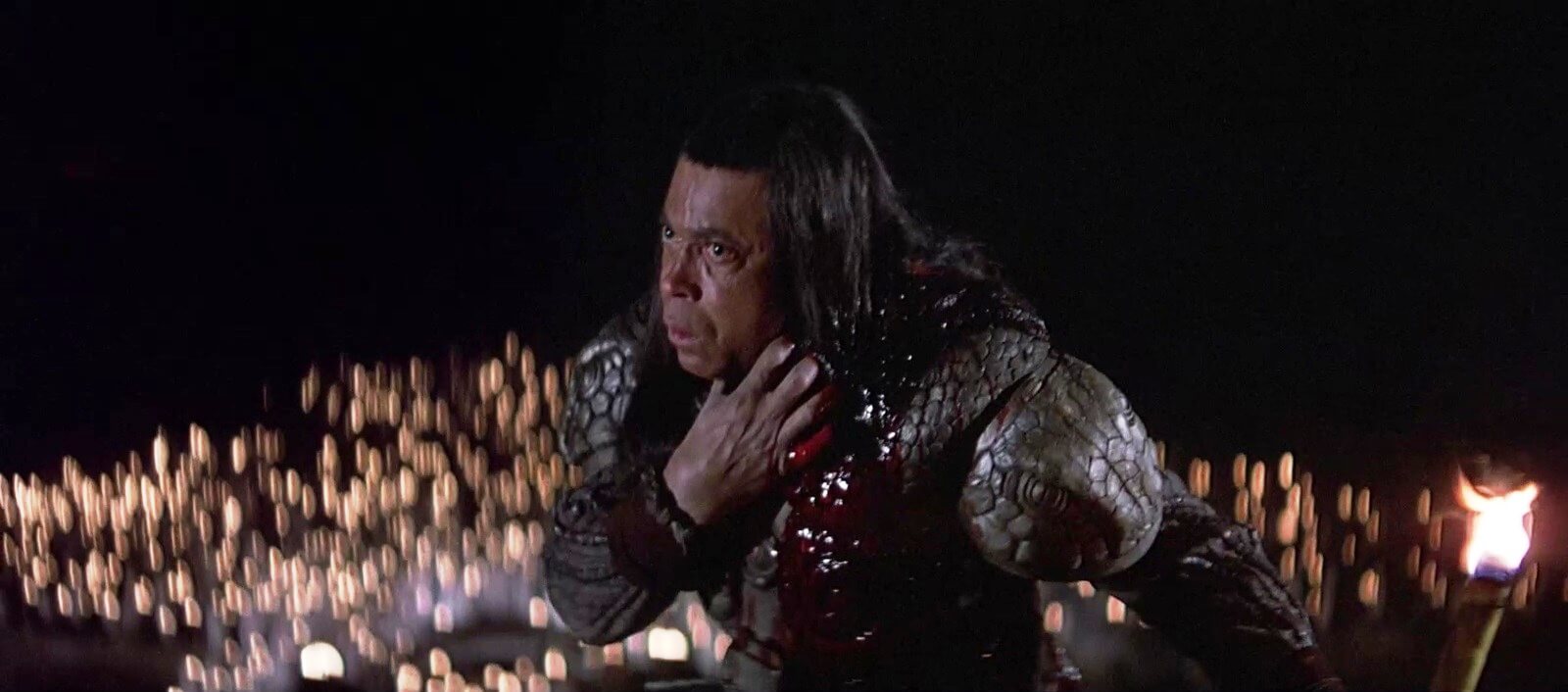
And some trivia
In the city scene, when Conan and Subotai are walking after consuming the black lotus, in the background, you can notice a man suspiciously adjusting his lame from behind… Regardless, maybe he was just adjusting its saddle.
For some reason, Arnold Schwarzenegger received a Razzie nomination for his role as Conan. It is pure absurdity, and rather a result of the jury’s habit of nominating Arnold – in my opinion, it is one of his best acting performances.
The painted face of Conan in the resurrection scene reminds one of the character’s face in the movie Kwaidan, which is another reference to Japanese art and culture in this film.
In the scene of Conan’s fight with one of Thulsa’s Brutes in the ruins, real swords were used, according to the director’s claim – a momentary oversight, and real blood could have been shed in that scene.
In the cut scene from the marketplace, where Conan buys lizards on a stick, the role of the delicacy seller was played by John Milius. This scene was included in the special edition of Conan.
There is also a second cut scene (in the special edition), in which Thulsa’s emissaries kill King Osric. If it had been included in the film, Conan’s loyalty and honor would have been emphasized even more (keeping the oath even after the death of the king).


